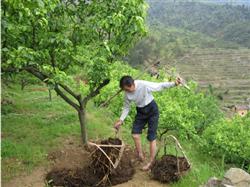Fertilization techniques for High yield of Chinese Chestnut
Chinese chestnut is mostly planted in mountain areas, which has strong adaptability, but the management is more extensive, but when Chinese chestnut blossoms and bears fruit, it needs a lot of nutrition to grow, and if the nutrition is insufficient, it will lead to a high rate of empty bracts, affecting yield and quality and reducing income. Therefore, chestnut planting should provide adequate fertilizer, but fertilization should not be carried out blindly. How to fertilize in order to achieve its high yield? Let's take a look.

1. Apply sufficient base fertilizer
Base fertilizer refers to the basic fertilizer needed for the growth of Chinese chestnut all the year round, and it is the clean point of fertilization technology of Chinese chestnut. After applying sufficient base fertilizer, the young trees planted in that year can promote their rapid growth, make them grow healthily, and lay the foundation for more blossoms and fruits in the future. After planting for many years, the plant with sufficient base fertilizer can enhance the photosynthetic efficiency of leaves, restore tree potential as soon as possible, supplement consumed nutrients, accumulate nutrients, and prepare for high yield in the coming year. The base fertilizer of young trees is applied before planting, and the fertilizer is turned into the soil layer combined with cultivated land after fertilization. generally, the base fertilizer is mainly organic fertilizer, supplemented by nitrogen, phosphorus and potassium fertilizer, with fully mature organic fertilizer 2000-3000 kg per mu, and 100,200kg nitrogen, phosphorus and potassium fertilizer per mu. For many years, the basic fertilizer of the plant is mainly organic fertilizer, which is fertilized according to the tree potential, soil fertility and fruiting trees. Generally, the trees with moderate tree potential, medium fertility and more fruit should apply 2000 kg organic fertilizer and 1.0kg-1.5kg sulfur-based compound fertilizer per plant.
2. Topdressing in time
In addition to applying sufficient basal fertilizer, plants have different nutrient requirements at different growth stages, such as very high nutritional requirements during flowering and fruiting, and there is little base fertilizer left at this time, so topdressing is needed to ensure plant growth. Generally, topdressing is needed three times a year, and the first time during flowering from March to April, the planting has enough nutrients to blossom and prepare for high yield. at this time, fertilization is mainly nitrogen fertilizer, supplemented by phosphorus and potassium fertilizer, and 0.5 kg of nitrogen fertilizer is applied to each plant. 0.1 kg of phosphorus and potassium fertilizer can promote the plant to develop leaves and shoots and improve the fruit setting rate. The second time in the full flowering period from May to June, topdressing fertilizer was applied to lay a good foundation for the results. This time, phosphorus and potassium fertilizer was also applied, but it should be noted that the proportion of nitrogen fertilizer decreased, while the proportion of phosphorus and potassium fertilizer needed to increase. The third time is in the fruit period from July to August, when the fruit is expanding and growing, it is necessary to apply appropriate amount of organic fertilizer and boron fertilizer, which can make the fruit full and increase the yield.
3. Spraying fertilizer on leaves
Chinese chestnut needs other trace elements during its growth, and the lack of these elements in planting may lead to symptoms such as leaf fading, yellowing and death, but fertilization can not supplement these nutrients in a short time, so foliar spraying is needed. Can quickly replenish what the plant needs. There are 3-4 times a year, the first time in May, when new leaves grow and begin to blossom, and spraying 0.3% 0.5% urea and borax can promote basic leaf function, improve photosynthesis and promote canned flower formation. The second time in June, 0.1% potassium dihydrogen phosphate can be sprayed once to improve the disease resistance of the plant. The third time, one month and half a month before harvest, 0.1% potassium dihydrogen phosphate was sprayed once or twice according to the plant condition, which could promote the nutrition transfer in the fruit, increase the grain weight, and significantly increase the yield.
The above is the whole content of high-yield fertilization technology of Chinese chestnut. I hope it can help you. If you want to know more about chestnut planting, please pay attention to us.
- Prev

Fertilizer application rate of red bayberry
Base fertilizer can be used with rotten fence compost, compost or cake fertilizer. Adult fruiting trees apply 25 kg of fence fertilizer or compost or 4 kg of cake fertilizer. Young trees apply 1-2 kg cake fertilizer. The first fruit tree applied 12.5 kg fence fertilizer + 20 kg coke ash. Strong fruit fertilizer: apply 1-3 kg potassium sulfate fertilizer or 25 kg coke ash. Postharvest fertilizer: can plant.
- Next

What about ginkgo fruit drop?
What about ginkgo fruit drop?
Related
- Moge, come on! The staff of the peasant association in the producing area of cantaloupe were frightened when the crowd gathered.
- Causes and Solutions of low Fruit setting rate of Apple
- Symptoms and control measures of passion fruit virus disease
- Fruit growing lesson: how do apple orchards keep high yields?
- Can you build orchards in the mountains? What are the pros and cons?
- How to manage the coloring period of Crisson grape?
- This paper introduces the processing technology of two kinds of fig products.
- How much is a month for retired teachers in rural areas by 2020?
- How can strawberry planting increase sugar content? We should pay attention to management in many aspects.
- What are the cultivation techniques on how to improve the yield of golden fruit?

